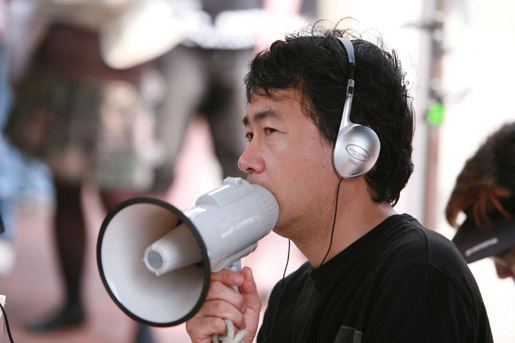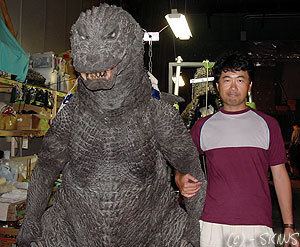Years active 1982 – Name Shusuke Kaneko | Siblings Jiro Kaneko | |
 | ||
Occupation Film directorScreenwriter Parents Tokuyoshi Kaneko, Shizue Kaneko Nominations Asian Film Award for Best Screenwriter Movies Death Note, Death Note 2: The Last Name, Godzilla - Mothra and King Ghid, Gamera: Guardian of the Uni, Gamera 3: The Revenge Similar People Rumi Hanai, Tatsuya Fujiwara, Kenichi Matsuyama, Ayako Fujitani, Takeshi Kaga | ||
Cross fire 2000 japanese trailer for shusuke kaneko s explosive pyrokinesis thriller
Shusuke Kaneko (金子修介, born 1955) is a Japanese screenwriter and director, best known as the director of the Heisei Gamera trilogy and Godzilla, Mothra & King Ghidorah: Giant Monsters All-Out Attack.
Contents
- Cross fire 2000 japanese trailer for shusuke kaneko s explosive pyrokinesis thriller
- Making Sense of the Mythology of the Heisei Gamera Trilogy
- Biography
- Director
- Assistant director
- Writer
- Special effects
- References

Making Sense of the Mythology of the Heisei Gamera Trilogy
Biography
Shusuke Kaneko was born in Tokyo, June 8, 1955. Drawn to film as a young boy, he filled his early years with science fiction and kaiju movies--giant Japanese monster such as Godzilla and Gamera. Much of TV in Japan in the early and mid-60s was made up of imported shows from America, and Kaneko's imagination was captured by their seemingly endless supply of fantastic themes and far-reaching stories. Among Kaneko's favorites at this time were Star Trek, Lost in Space and The Outer Limits.
When not propped in front of the family TV or seated in local cinema houses, Kaneko drew pictures of his favorite monsters, going so far as to collect many of them in his own personal book detailing the history and abilities of the kaiju of the era. Kaneko also created his own manga series for his friends and himself.
During his late teens, a screening of the US film The Strawberry Statement perked his interest with its modern sensibility and attempt to express the turmoil the students of that day were experiencing. Armed with an 8-mm camera, Kaneko and some of his friends created their own version of the film. Discovering he enjoyed the filmmaking process, Kaneko felt he had found his calling. However, the Japanese cinema industry was in the midst of a severe crash and though wanting a career in film, Kaneko didn't believe it feasible. Instead, he majored in education at Tokyo Gakugei University with the goal of becoming an elementary school teacher.
Yet his desire to be a director never left. Upon graduating he applied for and took the entrance exam at Nikatsu Studios. To his surprise, out of the three-hundred applicants, only he and one other man passed. Kaneko was immediately hired as an assistant director.
At this time, Nikatsu, one of Japan's oldest studios, had fallen upon difficult times. The once great studio, producers of some of the finest films in Japan, had seen ticket sales dwindle rapidly. Japanese sensibility had begun to experience a shift towards the more realistic and personal driven stories found in American cinema and the film industry in Japan was slow to keep up with this change. To stay afloat, Nikatsu and several other studios took to producing exploitation roman-porno films (short for romance pornography). These movies were quickly made love tales spiced up with partial nudity and sexually provocative situations. Kaneko labored through thirty-five of these productions as an A.D. while at Nikatsu. In addition, Kaneko also moonlighted as a writer of anime scripts, and penned several episodes of the then hugely popular [[|List of Urusei Yatsura episodes|Urusei Yatsura]] and Creamy Mami.
Kaneko directed his first film in 1984. The movie, Uno Koichiro no Nurete Utsu, was based on the works of erotic novelist Koichiro Uno. That year Kaneko also directed OL Yuri Zoku 19-Sai and Eve-chan no Hime, the latter netting him the "New Director Award" at the Yokohama Film Festival.
In 1985, Kaneko directed the film Minna Agechau (I'm All Yours). Though a sexual comedy about a young girl's quest to find true love and "lose it", it was the first mainstream attempt by Nikatsu in five years. The story was derived from a popular manga of the time. While still considered a newcomer within the industry, Kaneko had become widely recognized for a visual style that reflected Japanese manga sensibility.
Kaneko left Nikatsu and went freelance in 1985. His first film after leaving was the TV movie, The Samurai. This was a screwball comedy produced by Tsuburaya Productions that featured several special effect sequences.
Two of Kaneko's most endearing films were shot in 1988: Summer Vacation: 1999 and Last Cabaret. Both films helped to cement Kaneko's reputation as a force in Japanese cinema. The two films also earned him the notoriety as a director with the ability to photograph women in rich and alluring ways. Kaneko's ability to bring out their personal beauty and character made him much in demand and to this day remains a staple of his work. Summer Vacation: 1999 was shown in New York City and became his first film released on video outside Japan. Last Cabaret was one of the final roman porno films made by Nikatsu. The movie is considered an example of the best of the genre.
In 1993, Kaneko was invited to America to direct the sequence The Cold for the Brian Yuzna production Necronomicon. It was an experience that profoundly influenced Kaneko, as he has always revered the US style of filmmaking.
Kaneko continued directing for a variety of studios and quickly built an impressive resume.
When in 1993, Daiei Studios opted to revive their once popular Gamera series, Kaneko's name appeared on their short list of potential directors. Lobbying hard for the job, Daiei eventually awarded the directorial position to Kaneko. For this lifelong fan of kaiju, the task of creating his own film for the genre was the realization of a boyhood dream. Kaneko assembled a core creative staff consisting of then newcomer Shinji Higuchi as effect director, and Kazunori Ito as scriptwriter.
Gamera, Guardian of the Universe, released in 1995, was hailed for its sharp direction, realistic sensibility and groundbreaking effects. Kaiju films had originally begun in Japan with the first Godzilla motion picture in 1954 and remained more or less popular through the years. By 1995, however, they had been displaying a lack of originality and had fallen on tired clichés. Gamera was different, and the film successfully laid to rest any claims that the kaiju genre had gone dry. Kaneko followed the film with two successful sequels until retiring from Gamera in 1999.
In 1999 he began work on Cross Fire (foreign release title: Pyrokenisis). Released at the start of the summer of 2000, Pyrokinesis is considered his most polished work to date. It is also the first film Kaneko has made that was produced and lensed at Toho Studios, Japan's largest film studio. Pyrokinesis is currently being shown at film festivals in Hong Kong, Europe and the US.
At the time of this writing Kaneko is involved in many new and exciting projects. More will be added when information becomes available.
